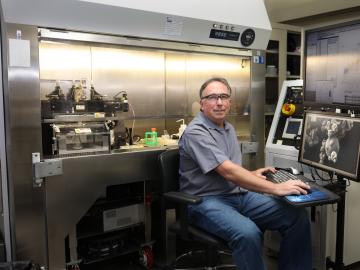Filter News
Area of Research
- (-) Clean Energy (60)
- (-) Computer Science (8)
- Advanced Manufacturing (6)
- Biological Systems (1)
- Biology and Environment (4)
- Building Technologies (1)
- Climate and Environmental Systems (2)
- Computational Engineering (1)
- Fusion Energy (6)
- Materials (55)
- National Security (5)
- Neutron Science (23)
- Nuclear Science and Technology (11)
- Quantum information Science (3)
- Supercomputing (31)
- Transportation Systems (1)
News Topics
- 3-D Printing/Advanced Manufacturing (12)
- Artificial Intelligence (6)
- Big Data (3)
- Bioenergy (7)
- Biomedical (1)
- Biotechnology (1)
- Clean Water (4)
- Composites (2)
- Computer Science (14)
- Cybersecurity (2)
- Energy Storage (4)
- Environment (12)
- Grid (2)
- Machine Learning (5)
- Materials Science (5)
- Mercury (1)
- Microscopy (1)
- Nanotechnology (2)
- Neutron Science (2)
- Nuclear Energy (1)
- Polymers (1)
- Quantum Science (1)
- Security (1)
- Space Exploration (1)
- Sustainable Energy (8)
- Transportation (10)
Media Contacts

Scientists at the U.S. Department of Energy’s Oak Ridge National Laboratory have demonstrated a way to isolate and grow targeted bacteria using genomic data, making strides toward resolving the grand challenge of uncultivated microbial “dark matter” in which the vast majority of microorganisms remain unstudied in the laboratory.

The National Alliance for Water Innovation, a partnership of the Department of Energy’s Oak Ridge National Laboratory, other national labs, university and private sector partners, has been awarded a five-year, $100 million Energy-Water Desalination Hub by DOE to address water security issues in the United States.

Three researchers at Oak Ridge National Laboratory will lead or participate in collaborative research projects aimed at harnessing the power of quantum mechanics to advance a range of technologies including computing, fiber optics and network

Quanex Building Products has signed a non-exclusive agreement to license a method to produce insulating material from ORNL. The low-cost material can be used as an additive to increase thermal insulation performance and improve energy efficiency when applied to a variety of building products.

Scientists at the US Department of Energy’s Oak Ridge National Laboratory have demonstrated a method to insert genes into a variety of microorganisms that previously would not accept foreign DNA, with the goal of creating custom microbes to break down plants for bioenergy.

A modern, healthy transportation system is vital to the nation’s economic security and the American standard of living. The U.S. Department of Energy’s Oak Ridge National Laboratory (ORNL) is engaged in a broad portfolio of scientific research for improved mobility

In collaboration with the Department of Veterans Affairs, a team at Oak Ridge National Laboratory has expanded a VA-developed predictive computing model to identify veterans at risk of suicide and sped it up to run 300 times faster, a gain that could profoundly affect the VA’s ability to reach susceptible veterans quickly.

A team including Oak Ridge National Laboratory and University of Tennessee researchers demonstrated a novel 3D printing approach called Z-pinning that can increase the material’s strength and toughness by more than three and a half times compared to conventional additive manufacturing processes.

Craig Blue, a program director at the Department of Energy’s Oak Ridge National Laboratory, has been elected a 2019 fellow for SME (formerly known as the Society for Manufacturing Engineers).

Isabelle Snyder calls faults as she sees them, whether it’s modeling operations for the nation’s power grid or officiating at the US Open Tennis Championships.




